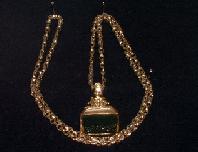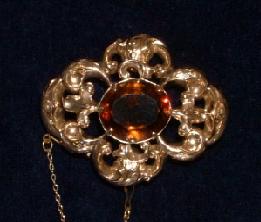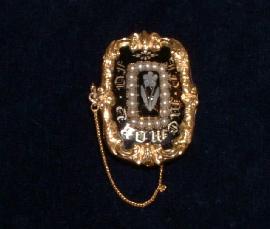|
|
|
Among the numerous artefacts
that the detectorist recovers from the soil is the odd piece of
attractive jewellery that ore forefathers used to wear in the
shape of finger rings, brooches, pendants, bangles etc. A number
of these objects bearing hallmarks of the late Victorian era were
mainly manufactured within the Birmingham area, which became a
hive of industry in the production of these intricate trinkets of
dressware. Vast quantities were produced during and after the
Silver Jubilee of Queen Victoria (1887); in spite of this it is
rare to find any two items which are identical in design,
especially where the brooches are concerned. In the early years
of Victoria’s reign it was only the very wealthy who could
afford jewellery, which was both high quality (i.e. diamonds,
emeralds, gold etc) and of exquisite design. Prior to 1887, one
of the most common materials used in the manufacture of jewellery
was Whitby jet, which was easily produced and was well within the
pocket of the ordinary working man or woman. For partly economic
reasons this type of jewellery was to become a firm favourite
with a large percentage of the population.
However on the sudden death of her beloved Prince Albert in 1861, it was Queen Victoria who was to set the fashion trend by her period of prolonged and deep mourning, which was to last over two decades. Black and other sombre garments were commonly worn by many of her loyal subjects (especially the ladies) and many accessories were also toned down to complement the clothing. This must have been ideal from the point of view of the jet industry, which had monopoly in this particular product. By 1870, 1500 men, women and children were employed in the industry, with over 100 dealers in and around the area. But the writing was on the wall; by 1884 fewer than 300 workers remained, and in 1885 an approach was made to the Princess of Wales to mediate with her majesty to relax the mourning code. It was almost two years later that the Queen agreed to wear the odd piece of silver jewellery on State occasions. This was just what the manufacturers of trinkets were waiting for; the general public had begun to tire of the long period of mourning. Again it was the Birmingham manufacturers who went into mass production with their modern presses that began stamping out all the bits and pieces to be assembles and soldered before the final finish. These items then appeared on the market throughout the British Isles, where even those of modest means could afford to purchase whatever took their fancy, either for themselves or loved ones.
 |
Heavy 9ct Gold filled fancy sealed fob inset with a dark green blood stone, on a Victorian belcher style chain tested to 9ct. The belcher is in lovely condition as it has internal links to protect against wear. It has a round box-snap fastner punch stamped 9ct. Chain weight 9.5 gms. 21 inches long. |
|
 |
 |
Early Victorian mourning brooch. A delicate flower centre carved in agate is surrounded by matching creamy white pearls. The black background with the words ' in memory of ' are framed by a beautifully scroll-worked edging. On the back there is a small hinged glass locket where a keepsake lock of hair would be placed. The inscription on the back reads ' Ann Painter Obt 29 April AT22. ' Tested to 9ct. Just under one and a half inches |
The Find Pages And Other Links